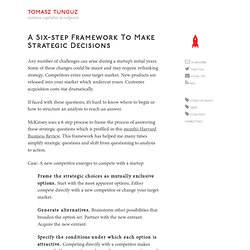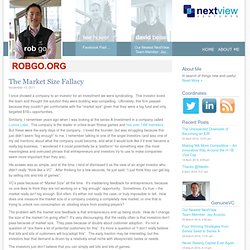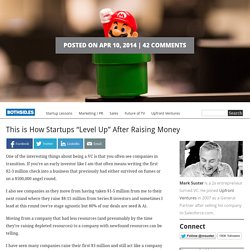

The Hidden Costs of the Switching Products in the Consumer Web. Michael Porter created the Five Forces Framework in 1979 in a landmark book called Competitive Strategy.

The Rule of 3 and 10. When to Be Strategic and When to Just Execute. Atomisation. The two strongest trends in Internet content are atomisation/unbundling on one hand and sealed silos within smartphone and tablets apps on the other.

This is contradictory. As we all know, many sites see the majority of their traffic going to individual pages rather than the home page, Tumblr and Pinterest disaggregate, reaggregate and remix individual pieces to content far away from where they started, and of course social sharing on Facebook or Twitter remixes and redistributes everything. Twitter cards and the trend for social messaging services to embed content within messages take this another step. In a sense, there is no home page for any site. Every piece of content becomes a packet that can be routed anywhere across any service layer - but the service layer is Twitter, Kik, Line or AirDrop, not TCP/IP or HTTP. A Dozen Things I’ve Learned About Strategy, Business and Investing From Michael Porter. Should Startups Focus on Profitability or Not? The only thing that matters.
This post is all about the only thing that matters for a new startup.

But first, some theory: If you look at a broad cross-section of startups — say, 30 or 40 or more; enough to screen out the pure flukes and look for patterns — two obvious facts will jump out at you. First obvious fact: there is an incredibly wide divergence of success — some of those startups are insanely successful, some highly successful, many somewhat successful, and quite a few of course outright fail. Second obvious fact: there is an incredibly wide divergence of caliber and quality for the three core elements of each startup – team, product, and market.
At any given startup, the team will range from outstanding to remarkably flawed; the product will range from a masterpiece of engineering to barely functional; and the market will range from booming to comatose. And so you start to wonder — what correlates the most to success – team,product, or market? A six-step framework to make strategic decisions. Any number of challenges can arise during a startup’s initial years.

Some of these changes could be major and may require rethinking strategy. Competitors enter your target market. New products are released into your market which undercut yours. Customer acquisition costs rise dramatically. If faced with these questions, it’s hard to know where to begin or how to structure an analysis to reach an answer. Capabilities and sensibilities. “The test of a first-rate intelligence is the ability to hold two opposed ideas in the mind at the same time, and still retain the ability to function.” – F.

Scott Fitzgerald One reason running a startup is so interesting is the constant tension between opposing ways of thinking: short-term vs. long-term, internal vs. external, saving vs. investment, etc. At large companies, responsibility for these ways of thinking is often spread across multiple business units. Changes in the rules of the [startup] game. The famous global macro hedge fund manager George Soros once said, “I don’t play the game by a particular set of rules; I look for changes in the rules of the game.”Inside the House of Money.
![Changes in the rules of the [startup] game](http://cdn.pearltrees.com/s/pic/th/changes-the-rules-startup-game-47425640)
The Market Size Fallacy « ROBGO.ORG. The Market Size Fallacy November 10, 2011 I once showed a company to an investor for an investment we were syndicating.

This investor loved the team and thought the solution they were building was compelling. Ultimately, this firm passed because they couldn’t get comfortable with the “market size” given that they were a big fund and only targeted $1B+ opportunities. The myth of the overnight success. Tech Angry Birds was Rovio’s 52nd game.

They spent eight years and almost went bankrupt before finally creating their massive hit. Pinterest is one of the fastest growing websites in history, but struggled for a long time. Pinterest’s CEO recently said that they had “catastrophically small numbers” in their first year after launch, and that if he had listened to popular startup advice he probably would have quit. You tend to hear about startups when they are successful but not when they are struggling. Startups are hard, but they can also go from difficult to great incredibly quickly. This is How Startups “Level Up” After Raising Money. One of the interesting things about being a VC is that you often see companies in transition.

If you’re an early investor like I am that often means writing the first $2-3 million check into a business that previously had either survived on fumes or on a $500,000 angel round. I also see companies as they move from having taken $1-5 million from me to their next round where they raise $8-15 million from Series B investors and sometimes I lead at this round (we’re stage agnostic but 80% of our deals are seed & A).
The Games Startups Play. Every startup plays two complementary games–the air game and the ground game.

The air game is always more romantic.